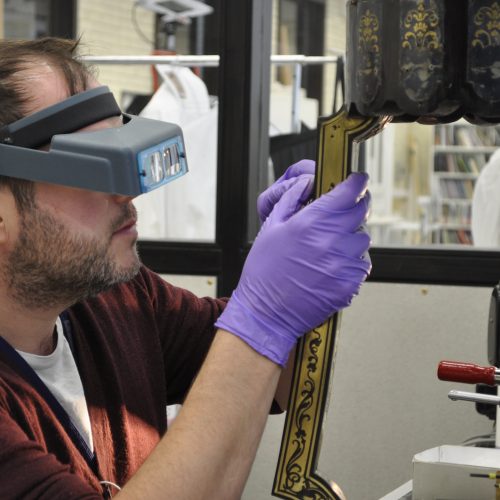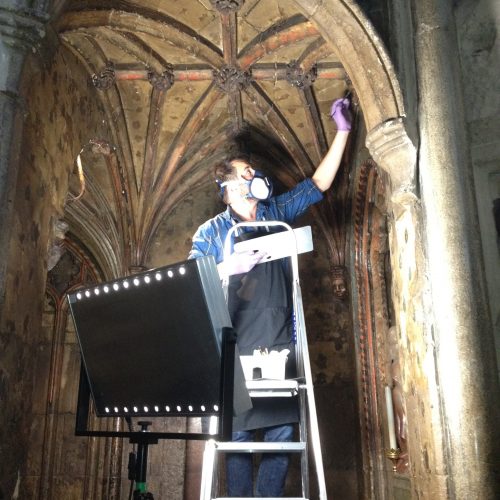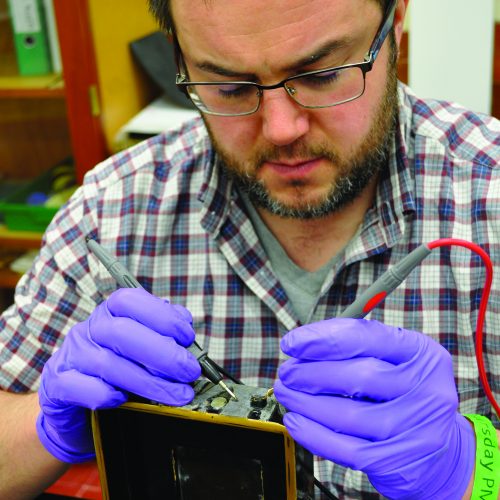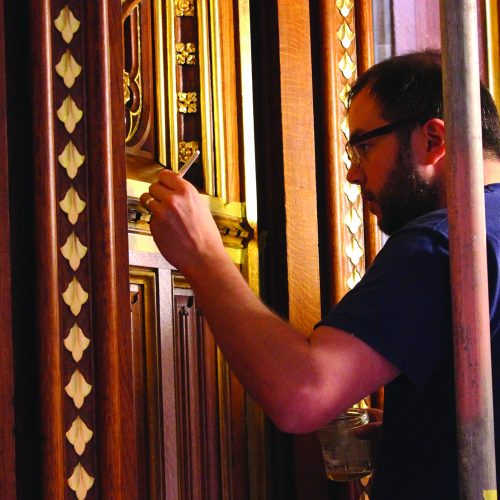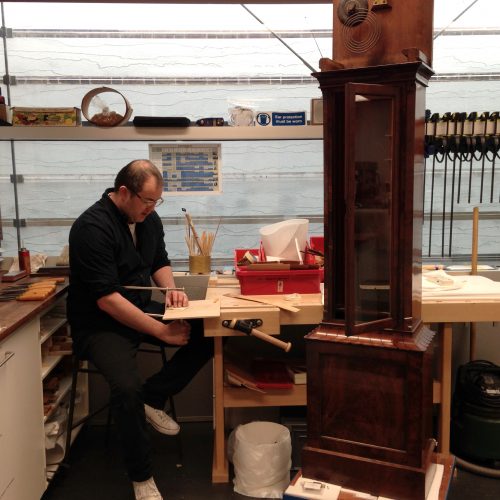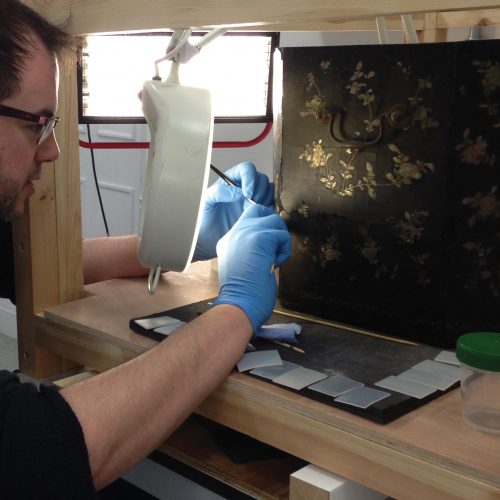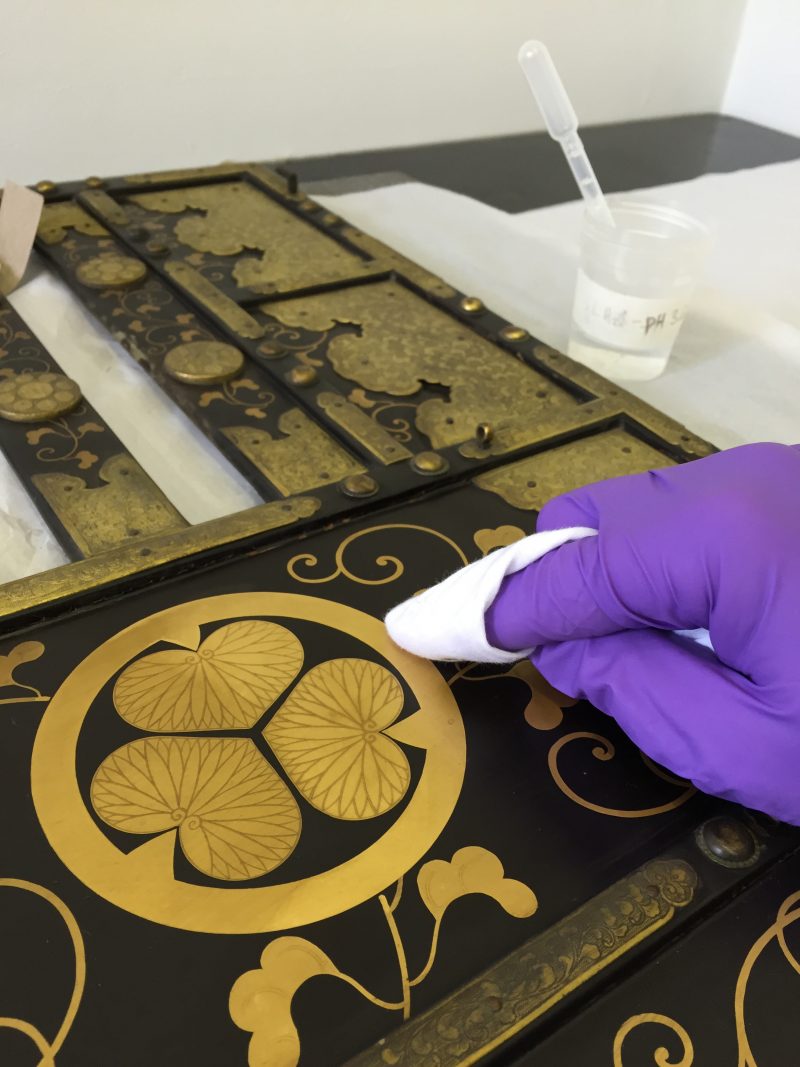
The BA Conservation course at City & Guilds is one of the most challenging things I’ve ever undertaken. The sheer scale of the course and the range of subjects students are expected to excel in cannot be understated. I can vividly remember that mingled sense of excitement and trepidation on receiving my first term’s timetable. Every day was full to bursting and the range of topics covered seemed so broad – wood carving, history of art, chemistry, and conservation ethics to name just a few. I couldn’t wait to get started.
I had no formal experience studying any of these topics; my first degree was in History and Philosophy. However, I had some creative and trades-based professional experience and had been volunteering with the National Trust prior to joining the course. Having graduated from the BA Conservation course, I feel comfortable discussing, describing, and applying knowledge learnt from across this broad syllabus.
So, if I was to choose one thing that has really stayed with me it would be the sense of privilege at being exposed to and encouraged to learn so many wonderful and disparate subjects. I can remember studying historical craft manuals in the morning and modern analytical techniques such as FTIR in the afternoon, perhaps a day’s life drawing followed by a day or two practicing how to produce and analyse cross sections sampling objects. This sense of the sheer scale of the course at City & Guilds has stayed with me into my professional life as I find myself able to hold my own in conversations with curators, scientists, crafts people, and a full range of other stakeholders.
I also particularly remember learning craft skills: gilding, wood carving, stone carving, lettering, japanning. I realised early on that while each craft discipline had its own very specific components, there was also a cumulative, transferable aspect to these skills. My understanding of the structure of wood or the composition of sedimentary stones was informed by my having cut and carved those materials; I watched my increasing brush skills, from having applied gessoes and pigmented shellacs and egg tempera paints, all funnel into a dramatically increased dexterity when working to consolidate Japanese lacquer or gilded surfaces; I saw my practical knowledge of the creation of multi-layered decorative surfaces from creating panel paintings, gilded, and japanned surfaces provide me with a deeper and more nuanced understanding of how these systems degrade and how they might respond to different treatments.
I can also say that many of the relationships I formed with tutors and peers have stayed with me. All of the tutors at City & Guilds are practicing experts in their respective fields. This means that they are able to deliver high-level, practical skills and experience to students while at college, but also means they continue as mentors, employers, or simply as a familiar and encouraging presence in the sometimes alarmingly small world of conservation upon graduation. Similarly, our year group has maintained contact despite our disparate trajectories since graduation, continuing to support and encourage each other throughout our various trials and successes.
The emphasis on practical applications for all the skills we were developing also proved invaluable. From early in my first year, lessons on basic object assessment and dry cleaning learnt in the classroom were applied at Westminster Abbey, Rochester Cathedral, and St. Bartholomew the Great church. From early in the second year we were working on objects owned by private clients and major heritage organisations and institutions. I found this exposure to real-world working conditions particularly helpful as it helped me to develop an appreciation of the importance of pragmatism and compromise, of deadlines, and of clients from the outset of my practice.
All of these factors have combined to mean that since graduation I have been continuously employed in one form or another. I have worked as a gilder, a stone conservator, a preventive conservator, a private furniture restorer, a conservator of gilded frames and furniture in private practice and a conservator of furniture and oriental lacquer at the Victoria and Albert Museum. All of this work has come in some way that’s to my association with City & Guilds, either directly through former tutors or peers, or as a result of the tireless work of Marina Sokhan in recommending and advocating for her graduates. It is only thanks to the diversity of the syllabus and the high, high quality of the teaching at City & Guilds that I have so comfortably been able to take on what at first glance may seem such diverse roles.
And it is thanks to this diversity of post-graduate experience, alongside my hard work organising conferences and events with the Institute of Conservation (Icon) via my involvement in their special interest groups, that I think played a vital role in securing me a permanent position at the British Museum as an organics conservator with special focus on wooden objects late in 2017. I feel like now, 3 years since graduating, the process of learning what it really is to be a conservator can really begin. Working as a permanent member of staff at a large national museum allows me to work on a wonderful array of objects, all of often very high quality or significance. But it also allows me to access training and conference attendance, to utilise the latest practical methods and analytical techniques, it will facilitate my path towards professional accreditation, allow me to learn from incredibly experienced and talent colleagues, and in time to begin to pass on some of what I’ve learnt.
I couldn’t have dreamed when I started at City & Guilds that within 3 years of graduation I would have landed my dream job, let alone that I would feel I had earnt it. I continue to believe that I am very privileged to do the work that I do, and without City & Guilds none of it would have been possible.
IMAGES
- © V&A, 2017. Cleaning lacquer.
- © V&A, 2016. Looking for areas of lifting brass and shell on a Boulle table.
- Retouching areas of loss in the entrance to the Chapel of St. John the Baptist, Westminster Abbey.
- Conducting experimental practical work on the electrolytic reduction of lead corrosion on lacquer.
- Oil gilding in the Sovereign’s Robing Room at the Palace of Westminster.
- © The Trustees of the British Museum. Shared under a Creative Commons Attribution-NonCommercial-ShareAlike 4.0 International (CC BY-NC-SA 4.0) licence. Carrying out veneer replacements on a long case clock.
- Consolidating a C19th export lacquer tea caddy for my 3rd year practical project at City & Guilds.



